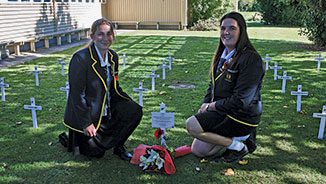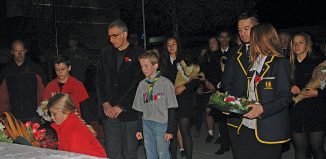
Otaki College held a very moving Anzac ceremony last Friday which included a slide show of 30 New Zealand soldiers who died at Gallipoli and other battle fields of World War 1.
All the students were in the hall for the first part of the ceremony and the commemorative slideshow which was followed by Otaki RSA president, Pat Kenny. He spoke briefly to the staff and students about the Great War as it became known. A second slide show of the poem In Flanders Field by Canadian physician Lieutenant Colonel John McCrae was shown, created and read by students. Everyone then left the hall for a traditional ceremony by the Field of Remembrance with the 30 white crosses. The haunting karanga of the women called everyone together at the flag pole. Principal Andy Fraser told the students of his own family connections at Gallipoli and other places of warfare.
“In this part of our service we commemorate those who gave their lives, the ultimate sacrifice,” he said.

The Last Post was played by bugler, Colin Honey, during which the national flag was lowered by one of the senior students and the head students read out the names of those who fell and were remembered in the slide show and crosses. Then followed the reading of the Ode with a response from everyone “We will remember them”, before a great hush came over the whole school as they stood together for a minute’s silence. The Anzac Lament was played by former teacher Don McAlpine on his bagpipes followed by the laying of flowers at the base of the flagpole and Reveille played as the flag was again raised.
It was assistant principal, Marion Lumley’s inspiration for the ceremony. She selected the names of the soldiers, from all around New Zealand and allotted them to several classes for the students to research and prepare for the slideshow. This gave their name, age, rank, date of their death and any medals awarded. Many students were quite taken aback by how young some of the men were, some not much older than those still at school.
The whole ceremony was very touching. The students respected the gravity of the occasion and the significance of the quiet times. There was an amazing hush over the whole school gathered at the Field of Remembrance.
Waitohu and Otaki schools held Anzac ceremonies too, with white crosses to commemorate those who died in service.

